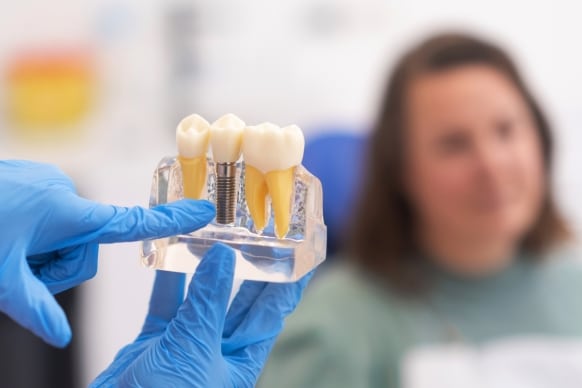Dental implants have transformed the landscape of tooth replacement. With approximately 120 million Americans missing at least one tooth and over 36 million lacking all their teeth, the impact is significant. Implant dentistry has revolutionized the approach to addressing lost teeth.
Whether you currently use full or partial dentures or require replacement for one or more missing teeth, dental implants offer the possibility of achieving the appearance, sensation, and functionality of natural teeth.
What Are Dental Implants?
A dental implant, also referred to as an endosseous implant or fixture, is a prosthesis that connects with the jaw or skull bone to support dental prostheses such as crowns, bridges, dentures, or facial prostheses, or to serve as an orthodontic anchor. Modern dental implants rely on osseointegration, a biological process in which materials like titanium or zirconia bond intimately with the bone. Surgeons position the implant fixture for potential osseointegration, followed by the addition of a dental prosthetic. Osseointegration necessitates a healing period before attaching the dental prosthetic (tooth, bridge, or denture) to the implant or placing an abutment to support a dental prosthetic/crown. Dentists surgically insert titanium screws into the jawbone in areas of missing teeth, enabling them to affix replacement teeth. The resulting crown closely resembles and functions like natural teeth.
Who Can Get Dental Implants?
For some individuals, traditional bridges and dentures may not be suitable due to reasons such as inadequate bone or tooth support, poor oral hygiene, discomfort, or gag reflex. Additionally, conventional bridges require the preparation of adjacent teeth to support the replacement tooth/teeth. One of the advantages of implants is that adjacent teeth do not need to be altered to accommodate the new replacement tooth/teeth.
To be eligible for implants, certain criteria must be met:
- Healthy gums
- Sufficient bone to support the implant or eligibility for bone grafting
- Commitment to excellent oral hygiene practices and regular dental check-ups to ensure the long-term success and health of the dental implants.
Types of Dental Implants
According to the American Academy of Implant Dentistry, there are two primary types of implants:
- Endosteal Implants: The most commonly used type, involves surgically placing them directly into the jawbone. After the surrounding gum tissue heals, a second surgery is necessary to attach a post to the original implant. Finally, an artificial tooth or teeth are affixed to the post, either individually or as part of a bridge or denture.
- Subperiosteal Implants: These implants are utilized for patients with insufficient healthy bone. Surgeons position a metal frame onto the jawbone beneath the gum tissue. As the gums heal, the frame becomes firmly attached to the jawbone. Posts, connected to the frame, protrude through the gums. Similar to endosteal implants, artificial teeth are then mounted to these posts.
Missing teeth can lead to oral health issues and affect your confidence while eating, speaking, or smiling. Dental implants offer an effective solution for improving both your dental health and self-assurance. If you’re in Haltom City, TX, considering dental implants, ABC 123 Dental can provide a long-lasting solution to restore your smile and oral functionality. Contact us today for a consultation!
When are Single Tooth Implants Used?
Dental implants offer a permanent solution for replacing missing teeth. Initially, your dentist surgically places the implant into your jawbone. Over time, the implant fuses with the bone, effectively serving as the new “root.” A crown, also known as a cap, is then attached to the implant to replace the missing tooth.
To be deemed a suitable candidate for dental implants, your jawbone must possess sufficient strength to support the implant. Additionally, the surrounding tissue and adjacent teeth should be in good health. If there is inadequate bone to support the implant, bone grafting procedures can be performed to augment bone density.
It’s imperative that your dentist conducts a comprehensive review of your medical history and performs a thorough examination. Certain medical conditions, such as diabetes, liver disease, or severe bleeding disorders, may disqualify you as a candidate for dental implants.
How do Single Tooth Implants Work?
A single-tooth implant comprises several components:
- The Implant: Typically crafted from titanium, this component resembles a screw or post and is inserted into the jawbone.
- The Abutment: Constructed from materials like titanium, gold, or porcelain, the abutment is affixed to the implant. It serves as the connection point between the implant and the crown.
- The Crown: Fabricated from materials such as porcelain fused to metal (PFM), all-metal, or all-porcelain, the crown is custom-made to match the color and shape of your natural teeth. It is attached to the abutment, completing the single-tooth implant restoration.
What is the Process of Single Tooth Implants?
The process of obtaining a single-tooth implant can span several months, but the results are rewarding. If your dentist determines that your jawbone lacks the necessary strength for the implant, bone grafting may be necessary. This involves augmenting the jawbone with bone from another source or synthetic material, requiring a healing period of 4-12 months before implant placement.
Implant Placement:
The implantation of a dental implant involves oral surgery, typically performed under local anesthesia. Your oral surgeon will incise the gum to expose the bone and drill holes into the bone for implant placement.
Following this procedure, a gap will remain where the tooth is missing. Your dentist may provide a temporary solution for cosmetic purposes during this interim period.
Placement of the Abutment:
After the successful fusion of the implant with the bone, your dentist may insert a healing cap to facilitate proper healing of the gum tissue, usually requiring about two weeks. Subsequently, the healing cap is removed, and the abutment is attached to the implant. During the gum’s final healing phase around the abutment, a temporary crown may be fitted.
Receiving the Crown:
Your dentist will take a final impression to fabricate your permanent crown, which will be cemented or screwed onto the abutment to secure it permanently. This new tooth can be maintained like any other with regular brushing and flossing to ensure gum health.
The process may vary for each single-tooth implant, with some steps potentially combined based on individual circumstances, as noted by the American Academy of Periodontology.
Potential Complications:
Implant failure may occur due to infection, bite misalignment, clenching or grinding teeth, or poor oral hygiene, and lack of regular professional care. Lower teeth implants pose the risk of injuring a nerve in the jawbone, resulting in temporary or permanent numbness or tingling. Additionally, implants placed in the upper jaw may lead to sinus problems if they protrude into sinus cavities, although such occurrences are rare.
While implant procedures require time and patience, ensuring the health and stability of the implant is essential. Once the implant and crown are in place, maintaining proper oral hygiene is crucial. For inquiries regarding dental implant procedures, including duration, it’s advisable to consult your dentist.





